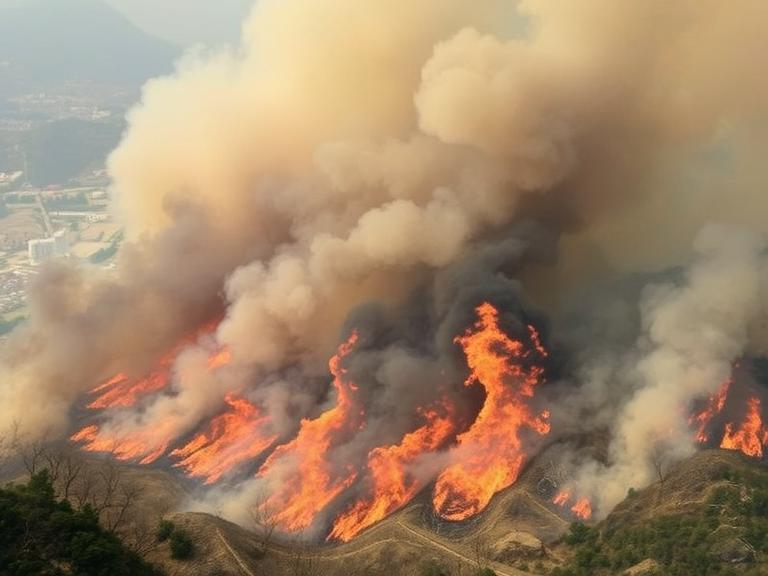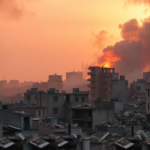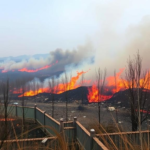In a devastating series of wildfires that erupted across southern South Korea, at least 24 individuals have lost their lives, and over 27,000 residents have been forced to evacuate. The infernos, fueled by strong winds and dry conditions, have scorched approximately 43,330 acres of land, leaving a trail of destruction in their wake.
The Onset and Spread of the Fires
The wildfires began in the southeastern regions, notably affecting areas such as Uiseong and Yeongdeok. Strong winds and arid weather conditions facilitated the rapid spread of the flames, overwhelming local firefighting resources and prompting urgent evacuations. The government responded by deploying a substantial force of approximately 4,650 firefighters, soldiers, and emergency personnel, supported by 130 helicopters, to combat the blazes.
Casualties and Evacuations
In a devastating series of wildfires that erupted across southern South Korea, at least 24 individuals have lost their lives, and over 27,000 residents have been forced to evacuate. The infernos, fueled by strong winds and dry conditions, have scorched approximately 43,330 acres of land, leaving a trail of destruction in their wake.
Tragically, the fires have claimed at least 24 lives, including a helicopter pilot who was actively engaged in firefighting operations. The swift advancement of the fires necessitated the evacuation of more than 27,000 residents from their homes to ensure their safety. Emergency shelters have been established to accommodate the displaced individuals, providing them with essential services and support during this challenging time.
Destruction of Property and Cultural Heritage
The wildfires have resulted in the destruction of over 200 structures, encompassing residential homes, commercial establishments, and public buildings. Among the most significant losses is the Gounsa Temple, a revered Buddhist site dating back to the 7th century. The temple suffered extensive damage, with approximately 20 of its 30 buildings consumed by the flames. Notably, two state-designated treasures, the “Gaunru” pavilion and the “Yeonsujeon” structure from the Joseon dynasty, were destroyed. Monks and temple workers managed to save an 8th-century stone Buddha statue, the temple’s third national treasure, along with other sacred artifacts.
Government Response and Relief Efforts
In response to the escalating crisis, the South Korean government elevated the wildfire warning to its highest level and designated the most severely affected areas as disaster zones to expedite relief and recovery efforts. Prime Minister Han Duck-soo emphasized the unprecedented nature of the damage and called for all available resources to be mobilized to contain the fires and support affected communities. Authorities are investigating the potential causes of the wildfires, with human error being a primary consideration.
Community Impact and Recovery
The impact on local communities has been profound, with thousands of individuals displaced and livelihoods disrupted. The destruction of homes and businesses has left many facing an uncertain future. Emergency services, alongside non-governmental organizations and volunteers, are working tirelessly to provide immediate assistance, including food, shelter, and medical care, to those affected. The government has pledged financial support and resources to aid in the rebuilding process, focusing on both physical infrastructure and the restoration of cultural heritage sites like the Gounsa Temple.
Environmental Consequences
The environmental ramifications of the wildfires are significant, with vast tracts of forest and agricultural land reduced to ashes. The loss of vegetation not only affects local biodiversity but also increases the risk of soil erosion and landslides in the coming months. Efforts to rehabilitate the affected ecosystems will be crucial in mitigating long-term environmental damage and supporting the return of wildlife to these areas.
Lessons and Future Preparedness
This disaster underscores the growing challenges posed by climate change, which has been linked to increased frequency and intensity of wildfires globally. Experts are calling for enhanced preparedness measures, including improved early warning systems, better forest management practices, and increased public awareness about fire prevention. Investing in these areas is essential to reduce the risk of future wildfires and to protect communities and cultural landmarks from similar tragedies.
As South Korea grapples with the aftermath of these devastating wildfires, the resilience and solidarity of its people remain evident. The collective efforts of emergency responders, government agencies, and local communities will be vital in the recovery and rebuilding process, aiming to restore normalcy and safeguard against future calamities.




